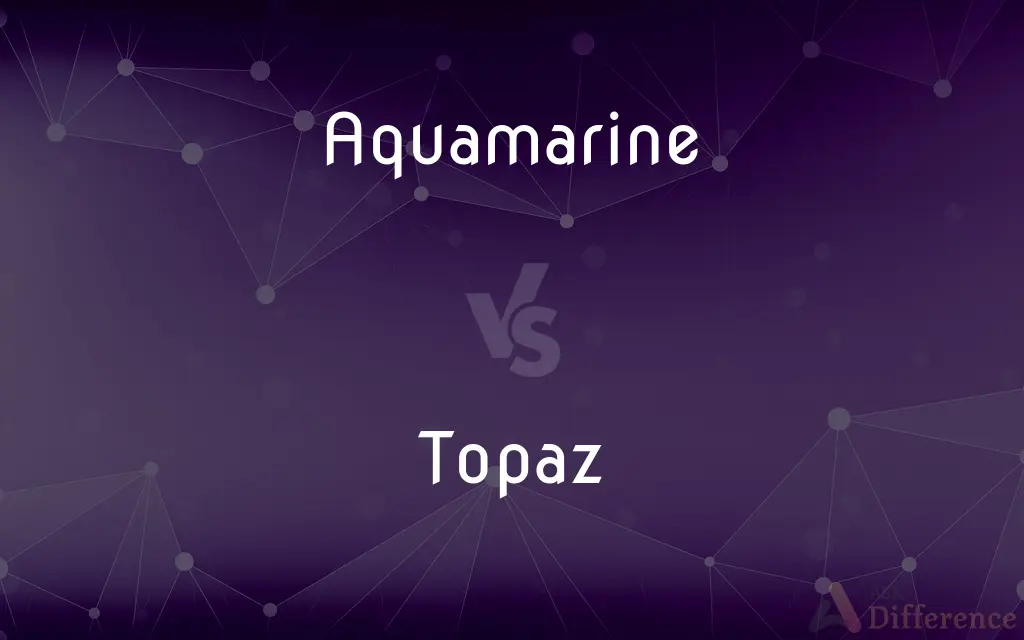Aquamarine vs. Topaz — What's the Difference?
Edited by Tayyaba Rehman — By Urooj Arif — Updated on April 8, 2024
Aquamarine is a blue to greenish-blue variety of beryl, known for its clarity and ocean-like colors, while topaz is a silicate mineral of aluminum and fluorine, famous for a wide range of colors including blue, yellow, orange, pink, and clear.

Difference Between Aquamarine and Topaz
Table of Contents
ADVERTISEMENT
Key Differences
Aquamarine, deriving its name from the Latin for seawater, is celebrated for its stunning sea-blue colors, ranging from the lightest blue to deep ocean blue, often associated with tranquility and eternal youth. Topaz, on the other hand, boasts a broader color spectrum, with its most prized variety being the imperial topaz, characterized by vibrant orange to pink hues, though blue topaz has become popular due to its availability and attractiveness.
The clarity of aquamarine is one of its most cherished qualities, with stones often being virtually free of inclusions, which makes them highly sought after for jewelry that demands clarity, such as engagement rings and pendants. While topaz also exhibits impressive clarity, it is more renowned for its hardness and durability, making it suitable for a wide array of jewelry applications.
Aquamarine is typically found in granite rocks and pegmatites and is most famously sourced from countries like Brazil, Madagascar, and Pakistan. Topaz can be found in a variety of geological environments, including granite rocks and lava flows, with significant sources in Brazil, Pakistan, and Russia, among others.
In terms of spiritual and healing properties, aquamarine is believed to soothe and calm, enhancing clarity of mind and facilitating communication. Topaz is thought to bring joy, generosity, abundance, and good health, with different colors of topaz associated with additional properties, such as the blue topaz promoting harmony and relaxation.
Despite their differences, both aquamarine and topaz are beloved in the gemstone world for their beauty and versatility in jewelry making. Whether chosen for their color, clarity, or purported healing properties, these gemstones continue to captivate and enchant.
ADVERTISEMENT
Comparison Chart
Composition
Blue to greenish-blue variety of beryl.
Silicate mineral of aluminum and fluorine.
Color Range
Shades of blue to greenish-blue.
Wide range, including blue, yellow, orange, pink, and clear.
Clarity
Known for high clarity, often free of inclusions.
Also exhibits high clarity, but prized for hardness and durability.
Geological Source
Found in granite rocks and pegmatites.
Found in various environments, including granite and lava flows.
Symbolism
Associated with tranquility, youth, and clarity of communication.
Believed to bring joy, generosity, and good health; varies by color.
Notable Sources
Brazil, Madagascar, Pakistan.
Brazil, Pakistan, Russia, among others.
Compare with Definitions
Aquamarine
Natural aquamarine often undergoes heat treatment to enhance its blue color.
The aquamarine’s vibrant blue hue was achieved through careful heat treatment.
Topaz
Topaz can be found in a wide array of colors from clear to deep blue, vibrant orange, and pink.
The jeweler showcased a topaz collection that spanned the spectrum from pale blue to fiery orange.
Aquamarine
Symbolizes tranquility, serenity, and clarity, often linked with the soothing aspects of water.
He gave her an aquamarine pendant to symbolize their peaceful and harmonious relationship.
Topaz
Known for its hardness, topaz is suitable for all types of jewelry, including rings and bracelets.
Her topaz earrings have maintained their shine and shape for years, testament to the gemstone's durability.
Aquamarine
Aquamarines are valued for their exceptional clarity and transparency.
Her aquamarine ring sparkled, clear and flawless under the sunlight.
Topaz
Associated with joy, generosity, and abundance, topaz is believed to bring positive energy to its wearer.
Wearing a topaz ring, she felt a sense of joy and wellbeing, reflecting the stone’s positive attributes.
Aquamarine
Primarily mined in Brazil, aquamarines are also found in Pakistan and Madagascar.
The Brazilian aquamarine is renowned for its size and deeply saturated colors.
Topaz
A silicate mineral that comes in a variety of colors, including the prized imperial topaz in shades of orange to pink.
The crown was set with a rare imperial topaz, its orange glow like a sunset.
Aquamarine
A gemstone of the beryl family, prized for its range of blue colors reminiscent of the sea.
The necklace was adorned with a stunning aquamarine centerpiece that mirrored the clear blue sky.
Topaz
Blue topaz, popular in jewelry, often receives treatment to achieve its color.
The bright blue topaz in her necklace had been irradiated to enhance its color.
Aquamarine
A transparent blue-green variety of beryl, used as a gemstone.
Topaz
Topaz ( TOH-paz) is a silicate mineral of aluminium and fluorine with the chemical formula Al2SiO4(F, OH)2. It is used as a gemstone in jewelry and other adornments.
Aquamarine
A pale blue to light greenish blue.
Topaz
A precious stone, typically colourless, yellow, or pale blue, consisting of an aluminium silicate that contains fluorine.
Aquamarine
The bluish-green colour of the sea.
Topaz
A large tropical American hummingbird with a yellowish throat and a long tail.
Aquamarine
A bluish-green variety of beryl.
Topaz
A colorless, blue, yellow, brown, or pink aluminum silicate mineral, often found in association with granitic rocks and valued as a gemstone.
Aquamarine
Of a bluish-green colour.
Topaz
Any of various yellow gemstones, especially a yellow variety of sapphire or corundum.
Aquamarine
A transparent, pale green variety of beryl, used as a gem. See Beryl.
Topaz
A light yellow variety of quartz.
Aquamarine
A transparent variety of beryl that is blue green in color
Topaz
A silicate mineral of aluminium and fluorine, usually tinted by impurities.
Aquamarine
A shade of blue tinged with green
Topaz
An often clear, yellowish-brown gemstone cut from this.
Topaz
A yellowish-brown color, like that of the gemstone.
Topaz
A black Catholic soldier in the British Army.
Topaz
Either of two species of very large hummingbirds in the genus Topaza.
Topaz
A ruby-topaz hummingbird, Chrysolampis mosquitus, the male of which has bright ruby feathers on the head and topaz on the throat
Topaz
Of a yellowish-brown color, like that of the gemstone.
Topaz
A mineral occurring in rhombic prisms, generally yellowish and pellucid, also colorless, and of greenesh, bluish, or brownish shades. It sometimes occurs massive and opaque. It is a fluosilicate of alumina, and is used as a gem.
Topaz
Either one of two species of large, brilliantly colored humming birds of the genus Topaza (Topaza pella or Topaza pyra), of South America and the West Indies.
Topaz
A yellow quartz
Topaz
A mineral (fluosilicate of aluminum) that occurs in crystals of various colors and is used as a gemstone
Topaz
A light brown
Common Curiosities
Which gemstone is harder, aquamarine or topaz?
Topaz is harder and more durable than aquamarine, making it suitable for a wide variety of jewelry applications.
What is aquamarine known for?
Aquamarine is celebrated for its sea-blue colors and exceptional clarity, symbolizing tranquility and eternal youth.
What makes topaz unique?
Topaz stands out for its broad color spectrum and durability, with imperial topaz being especially valued for its vibrant colors.
Can aquamarine and topaz have similar colors?
Yes, both can exhibit blue hues, but the specific shades and intensity differ, with blue topaz often being treated to achieve its color.
How are the colors of aquamarine and topaz different?
Aquamarine exhibits blue to greenish-blue hues, reflecting colors of the sea, while topaz can be found in a range of colors including blue, yellow, orange, pink, and clear.
What are the healing properties of topaz?
Topaz is believed to bring joy, generosity, abundance, and good health, with specific colors associated with additional properties.
Where is aquamarine most commonly found?
Aquamarine is primarily sourced from Brazil, Madagascar, and Pakistan, among other locations.
Which gemstone is more expensive?
The price of each gemstone can vary widely based on color, clarity, size, and origin, but generally, high-quality aquamarine and imperial topaz are considered more valuable.
Are aquamarine and topaz treated for color enhancement?
Blue topaz is often treated to achieve its color, while aquamarine’s natural color is typically light and may be deepened through heat treatment.
How can I tell the difference between aquamarine and blue topaz?
While both can be blue, aquamarine typically has a softer, more subtle range of blue to greenish-blue shades, whereas blue topaz can display a more vivid and broader range of blue hues.
Share Your Discovery

Previous Comparison
Stock vs. Flow
Next Comparison
Oligarchy vs. MonarchyAuthor Spotlight
Written by
Urooj ArifUrooj is a skilled content writer at Ask Difference, known for her exceptional ability to simplify complex topics into engaging and informative content. With a passion for research and a flair for clear, concise writing, she consistently delivers articles that resonate with our diverse audience.
Edited by
Tayyaba RehmanTayyaba Rehman is a distinguished writer, currently serving as a primary contributor to askdifference.com. As a researcher in semantics and etymology, Tayyaba's passion for the complexity of languages and their distinctions has found a perfect home on the platform. Tayyaba delves into the intricacies of language, distinguishing between commonly confused words and phrases, thereby providing clarity for readers worldwide.














































